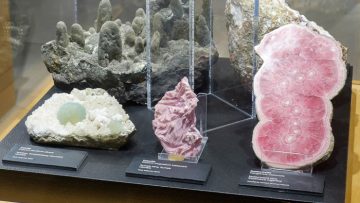Grades K-12 | 4+ hours

Planet Earth is an amazing place, filled with volcanoes, glaciers, minerals, and oceans, along with millions of species of organisms. The Beaty Biodiversity Museum and Pacific Museum of Earth (PME) have joined forces to offer tours and programs to complement your science curriculum. Located less than a 5-minute walk apart, the Beaty and PME are perfect field trip locations to combine for a full-day visit to UBC. By taking part in Earth Experience, students will explore the amazing natural forces that shape the earth and how this has influenced the variety of insects, plants, and animals around us.
This new combined booking option allows your students to explore two great UBC museums, and enjoy two amazing school experiences in one day – for one low cost! Customize the experience to fit the needs of your students by selecting:
- One of the Beaty’s in-person school programs or museum tour (60-75 minutes)
— AND —
- One PME In-person tour or program (75 minutes)
- Please download and print the scavenger hunt ahead of time for your students.
- Download the scavenger hunt answer key.
Free time will be set aside to enjoy your packed lunch outdoors and explore the museums at your own pace.
This is a special program with limited availability, running only on Tuesdays from 10:15 am - 2:30 pm. Please scroll through the calendar to find upcoming dates that are still available.
The fee for the program is $600 (including tax) which includes entrance for the day to both the Beaty Biodiversity Museum and the Pacific Museum of Earth as well as one museum-led experience at each location. All experiences start at the Beaty Biodiversity Museum. Please meet at the Beaty Museum admission desk and we will escort you to the PME.
Many of our Educator Resources can support your visit.
You can also use the Pacific Museum of Earth's scavenger hunt! Download and print the scavenger hunt ahead of time for your students. Print on both sides of paper and/or print one copy for groups of 2 to 3 students to reduce waste. Download the scavenger hunt answer key.
Dependent on your choice of Beaty Museum program or tour and Pacific Museum of Earth workshop or tour. Science highlights include:
- Kindergarten: Plants and animals have observable features
- Science 1: Living things have features and behaviours that help them survive in their environment
- Science 2: All things have a life cycle
- Science 3: Living things are diverse, can be grouped, and interact in their ecosystems
- Observable changes in the local environment caused by erosion and deposition by wind, water, and ice
- Science 4: All living things and their environment are interdependent
- Science 5: Multicellular organisms have organ systems that enable them to survive and interact within their environment
- The rock cycle
- Science 6: Multicellular organisms rely on internal systems to survive, reproduce, and interact with their environment
- Science 7: The theory of evolution by natural selection provides an explanation for the diversity and survival of living things
- Fossil records and geological dating
- Science 8: The theory of plate tectonics is the unifying theory that explains Earth’s geological processes; cells are a basic unit of life
- Plate tectonic movement, major geological events of local significance, layers in earth
- Science 9: The biosphere, geosphere, hydrosphere, and atmosphere are interconnected, as matter cycles and energy flows through them.
- Science 10: Genes are the foundation for the diversity of living things
- Biology 11: All organisms have characteristics that define them as living and interdependent. Life can be organized in a functional and structural hierarchy ranging from cells to the biosphere; living things are interdependent; living things are diverse and evolve over time
- Biology 12: Cells are the basic unit of life
Explore the Beaty Museum’s program pages for additional content links by grade.
